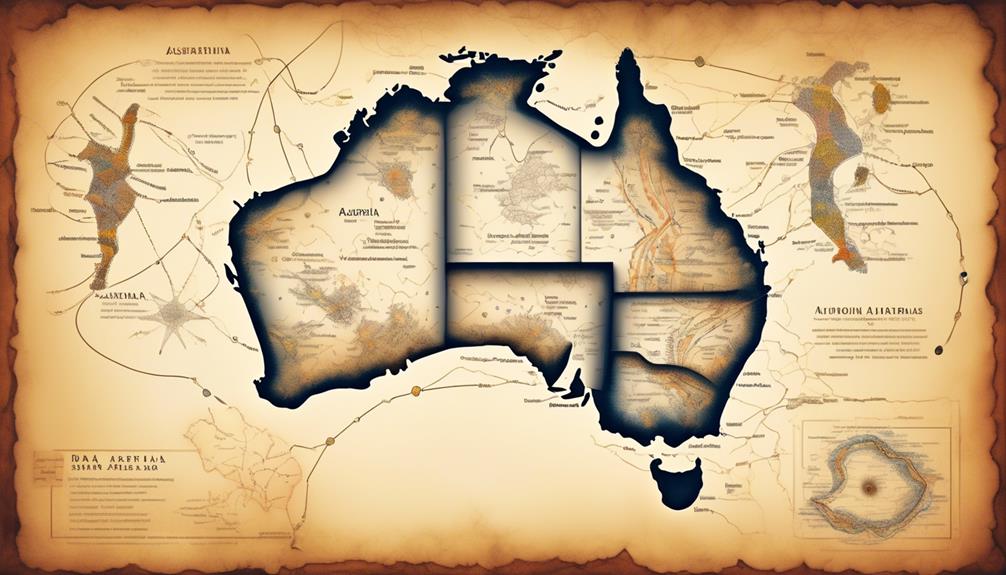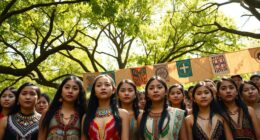The Center for Aboriginal Human Resource Development (CAHRD) has unquestionably solidified its reputation as a crucial organization for Indigenous communities across the country. Its unwavering commitment to providing comprehensive programs and services has had a profound impact on the lives of many individuals.
From empowering community members with essential skills to fostering sustainable employment opportunities, CAHRD has consistently demonstrated its dedication to fostering positive change. But what really sets CAHRD apart is its ability to not only address immediate needs but also to pave the way for long-term success.
As we explore the history, current initiatives, and future prospects of this remarkable organization, it becomes evident that its impact is far-reaching and its potential for continued growth is inspiring.
Key Takeaways
- CAHRD was established in 1982 with a mission to support the professional and personal growth of Indigenous peoples.
- The organization recognizes the importance of community partnerships and develops initiatives with input from Indigenous leaders and organizations.
- CAHRD offers tailored educational programs, job search assistance, and culturally relevant guidance to support academic and vocational pathways for Indigenous individuals.
- The organization's impact on Indigenous communities includes preserving languages and traditions, promoting economic growth, fostering self-sufficiency, and empowering individuals to contribute to cultural identity and economic well-being.
History of CAHRD
Since its establishment in 1982, the history of the Aboriginal Human Resource Development Center (AHRDC) has been characterized by a commitment to fostering the professional and personal growth of Indigenous peoples.
The Center for Aboriginal Human Resource Development (CAHRD) was founded to address the unique employment and training needs of the Indigenous community. From the outset, CAHRD recognized the importance of forging strong community partnerships to effectively serve Indigenous peoples. These partnerships have been instrumental in shaping the programs and services offered by CAHRD, ensuring they're culturally relevant and responsive to the needs of the community.
The founding of CAHRD was a collaborative effort that involved input from various Indigenous leaders, community members, and organizations. This collective approach allowed CAHRD to develop initiatives that resonate with the aspirations and values of the Indigenous peoples it serves.
Programs and Services

How do the programs and services offered by the Aboriginal Human Resource Development Center (AHRDC) cater to the specific needs and aspirations of the Indigenous community? At AHRDC, we are committed to providing education opportunities and employment support that align with the cultural values and individual goals of the Indigenous community. Our programs and services are designed to empower individuals with the skills, knowledge, and confidence needed to succeed in their chosen career paths while honoring their cultural heritage. Through culturally sensitive and collaborative approaches, we strive to create a supportive environment that fosters personal and professional growth.
| Programs | Description | Benefits |
|---|---|---|
| Education | Tailored educational programs and resources | Empowering individuals with knowledge |
| Employment | Job search assistance and skill development | Facilitating career advancement |
| Mentorship | Culturally relevant guidance and support | Nurturing personal and professional growth |
Our education opportunities encompass a range of academic and vocational pathways, ensuring that individuals have access to learning experiences that resonate with their cultural background. Additionally, our employment support services offer practical assistance in navigating the job market while providing skill development opportunities that align with both traditional values and modern workplace demands. Through mentorship, we aim to foster a sense of community and provide culturally relevant guidance to support individuals on their journey towards fulfilling their aspirations.
Impact on Indigenous Communities
Having witnessed the positive impact of our programs and services on Indigenous individuals, we're committed to highlighting the profound influence of the Aboriginal Human Resource Development Center (AHRDC) on Indigenous communities.
Our work extends beyond individual empowerment; it encompasses the broader goal of fostering sustainable development within Indigenous communities. Through our initiatives, we've observed the following effects:
- Cultural Preservation: Our programs actively support the preservation of Indigenous languages, traditions, and knowledge systems. By incorporating traditional teachings into our training and educational efforts, we honor and safeguard the cultural heritage of Indigenous communities.
- Economic Development: The AHRDC plays a pivotal role in promoting economic growth within Indigenous communities. By providing access to skill development, employment opportunities, and entrepreneurial support, we contribute to the economic prosperity of Indigenous peoples, thereby fostering self-sufficiency and resilience.
The impact of the AHRDC on Indigenous communities is profound, as it not only empowers individuals but also contributes to the preservation of cultural identity and the advancement of economic well-being. We remain dedicated to continuing our collaborative efforts in furthering these positive impacts.
Success Stories

We have been humbled by the inspiring success stories that have emerged from our programs and services, reflecting the transformative impact of the Aboriginal Human Resource Development Center on Indigenous communities. Through our commitment to career advancement and personal development, we've witnessed remarkable journeys of individuals overcoming challenges and achieving their goals.
One such story is that of a young Indigenous woman who, with the support and guidance provided by our center, was able to secure a meaningful job in her desired field. Through our career development programs, she gained the necessary skills and confidence to pursue her aspirations, ultimately leading to her employment in a position that not only sustains her financially but also fulfills her passion for helping others.
Similarly, a young man who'd faced numerous setbacks found renewed hope and purpose through our personal development workshops. He emerged from our programs with a newfound sense of self-worth and resilience, enabling him to pursue further education and ultimately launch a successful business in his community.
These success stories are a testament to the potential for positive change and growth within Indigenous communities, and we're continually inspired by the determination and achievements of those we've the privilege to serve.
Future Initiatives
In our ongoing commitment to serving Indigenous communities, we're actively planning new initiatives to further empower individuals through enhanced resources and support. As we look ahead, our focus is on developing innovative strategies and fostering community partnerships to create meaningful impact.
Here's a glimpse of our upcoming initiatives:
- Tailored Skills Development Programs: We're dedicated to designing specialized training programs that align with the unique needs and aspirations of Indigenous individuals. By tailoring our approach, we aim to provide relevant skills development opportunities that support long-term career growth and economic independence.
- Expanded Mentorship Networks: Building on the success of our existing mentorship programs, we're expanding our network of mentors to offer guidance and support to a broader range of individuals. Through these relationships, we seek to foster personal and professional growth while preserving cultural heritage and knowledge transfer.
- Entrepreneurship Incubator: We're laying the groundwork for an entrepreneurship incubator that will offer aspiring Indigenous entrepreneurs access to resources, mentorship, and funding opportunities. By nurturing entrepreneurial spirit, we aim to cultivate sustainable economic development within Indigenous communities.
As we move forward, we're committed to embracing new and innovative approaches while strengthening our collaborative efforts with community partners.
Frequently Asked Questions
What Are the Specific Challenges Faced by Indigenous Individuals in Accessing Employment and Training Opportunities in Winnipeg?
Accessing employment and training opportunities in Winnipeg presents challenges for indigenous individuals. These challenges include systemic barriers, discrimination, and lack of culturally relevant support.
However, there are solutions to these challenges. One solution is to provide targeted training programs that specifically address the needs and aspirations of indigenous individuals. By offering training programs that are culturally relevant and tailored to their unique experiences, we can increase their chances of success in accessing employment opportunities.
Another solution is to foster partnerships with employers. By establishing relationships with employers who are committed to diversity and inclusion, we can create more opportunities for indigenous individuals to access employment. These partnerships can include initiatives such as job fairs, mentorship programs, and internships that provide hands-on experience in the workplace.
Advocating for inclusive hiring practices is also crucial. This involves promoting policies and practices that ensure fair and equal treatment of indigenous individuals in the hiring process. By advocating for inclusive hiring practices, we can challenge discriminatory practices and create a more level playing field for indigenous individuals.
How Does CAHRD Collaborate With Local Businesses and Organizations to Create Employment Opportunities for Indigenous Peoples?
Collaboration with local businesses and organizations is key to creating Indigenous employment opportunities.
Through community engagement and partnerships, we foster economic opportunities for Indigenous peoples.
By working together, we can address the specific challenges faced by Indigenous individuals in accessing employment and training opportunities.
Our approach is respectful, culturally sensitive, and focused on fostering meaningful connections between Indigenous communities and local businesses to create sustainable employment pathways.
What Is the Process for Indigenous Individuals to Access Funding and Support for Training and Education Programs Through Cahrd?
Accessing funding and support for training and education programs involves applying through our organization. We facilitate the funding process by assisting indigenous individuals in navigating the application requirements and connecting them with available resources.
Our support programs offer guidance and mentorship to ensure success in accessing the necessary financial assistance for education and training.
We're committed to empowering indigenous individuals through accessible pathways to education and training opportunities.
How Does CAHRD Address the Unique Cultural and Historical Barriers That Indigenous Individuals May Face in the Workforce?
In addressing the unique cultural and historical barriers faced by Indigenous individuals in the workforce, we prioritize cultural sensitivity, recognizing historical trauma, and ensuring workplace inclusivity.
Our approach acknowledges the complexities of Indigenous workforce barriers and aims to create an environment that respects and honors diverse cultural backgrounds.
What Steps Is CAHRD Taking to Expand Its Reach and Impact in Other Indigenous Communities Across Canada?
To expand our impact, we prioritize building relationships with Indigenous communities across Canada. Our outreach efforts involve collaborating with local leaders, participating in community events, and offering tailored programs that address specific needs.
Conclusion
In conclusion, CAHRD has truly made a positive impact on Indigenous communities through its programs and services. We've seen firsthand the transformation and success stories that have come out of this organization.
As we look towards the future, we're excited to continue working collaboratively with Indigenous communities to develop new initiatives and create even more opportunities for success.
Together, we can make a real difference.
Nayeli is our dedicated Editor in Chief, bringing her passion for words and keen editorial eye to every piece of content we produce. With years of experience in the field, she ensures that every article and publication meets the highest standards of quality and clarity. Nayeli’s commitment to storytelling and her deep understanding of our mission make her an invaluable leader in our team.










